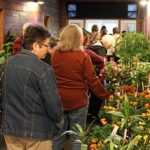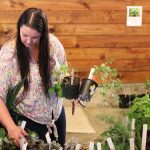Master Gardeners learn importance of pollinators
By John Miller, 04/22/24 10:20 AM
PRESCOTT – Pollination and pollinators are vital in the circle of life.
This is what visitors to the Barn at Willow Oaks were told at the 14th Annual Nevada County Master Gardener Plant show and Sale Saturday. Amanda Malcolm, owner-operator of Love Creek Nursery in Okolona, told the packed house how she got started in business, but focused on the importance of planting things important to pollinators – primarily bees and butterflies. She said wildflower plots don’t need to be watered as they’ll take care of themselves.
Malcolm pointed out honeybees, and other bees add around $15 billion to the economy annually, but honeybees are on the decline as they’re being killed by pesticides. She said the bee population needs to be improved as bees pollinate so many plants. Seventy-five percent of local crops and 90 percent of plants nationally are pollinated by pollinators like bees and butterflies. These pollinators need sun and nectar, along with a pesticide-free environment – especially butterflies.
Butterflies also need larval host plants in order to propagate. Honeybees, on the other hand, generally like all flowers. A single bee will forage up to three miles from its hive, she said, and the average hive has around 50,000 bees. It takes about two million bees, Malcolm continued, to make a pound of honey. A single bee will make 1/12 of a teaspoon of honey in its life and have a lifespan of roughly four weeks.
Bees, she said, do buzz pollination by creating a vibration on the flowers, stirring up the pollen inside. This helps some plants give a larger yield. While pretty much everyone considers carpenter bees a pest, Malcolm said they are excellent pollinators for several kinds of plants, such as tomatoes and blueberries. These, though are solitary bees having no community. To keep them from harming homes, she suggested putting up a piece of wood with holes drilled in it and covered with wire to keep birds out.
In talking about butterflies, Malcolm said there are around 134 species in Arkansas and can be seen year round. However, as butterflies undergo metamorphosis, their larva needs to be left alone when found on plants. Unlike bees, butterflies need different plants depending on their species. The state’s butterfly is the Diana Fritilary and it’s at risk of extinction in the northwest part of the state. This kind of butterfly is an Arkansas specific subspecies no one talks about.
She suggested planting yarrow as it’s a good medicinal plant along with being an excellent pollinator plant.









